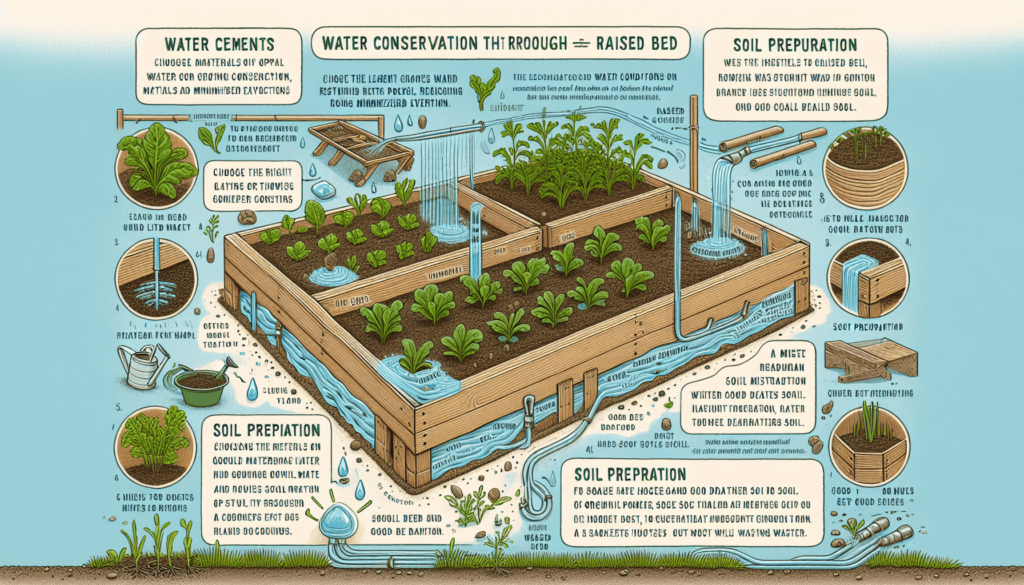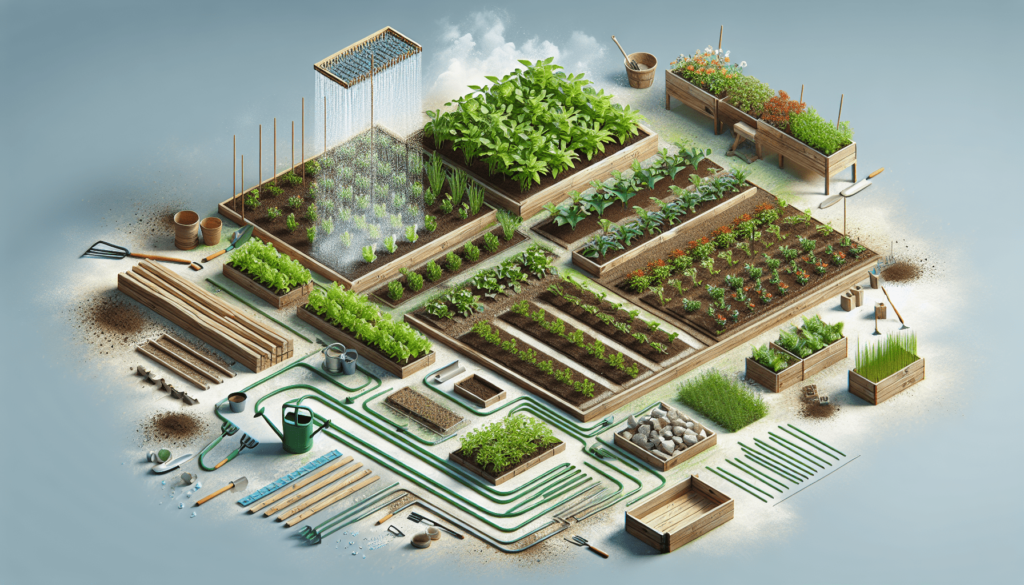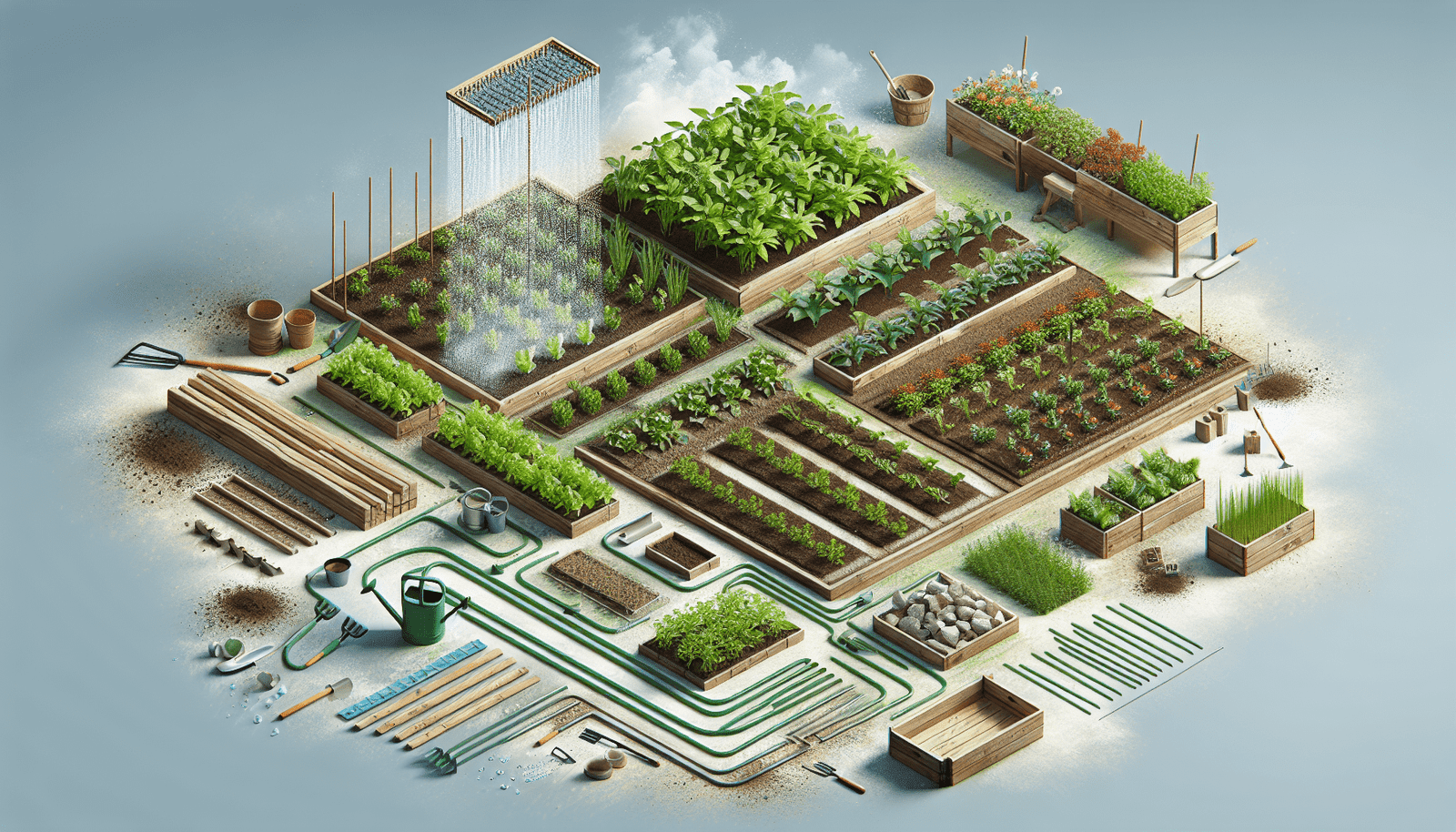In this article, you will discover the wonderful world of raised bed gardening, an innovative and sustainable approach to gardening that not only allows you to grow a variety of wholesome vegetables and herbs but also helps conserve water. With raised beds, you’ll learn how to optimize water usage and create a landscape where plants thrive while minimizing water wastage. So whether you’re an experienced gardener or a beginner, get ready to explore the benefits of raised bed gardening and how it can contribute to water conservation in a friendly and eco-friendly manner. Raised bed gardening is a popular and effective way to grow plants in a controlled environment. Not only does it offer numerous benefits in terms of plant health and productivity, but it also provides opportunities for water conservation. In this article, we will explore the various benefits of raised bed gardening and discuss strategies to conserve water in your raised bed garden.

Benefits of Raised Bed Gardening
Improved Soil Drainage
One of the key benefits of raised bed gardening is improved soil drainage. By elevating the soil level, excess water can easily drain away, preventing the plants from becoming waterlogged. This is particularly beneficial in areas with heavy rainfall or poorly drained soil. With proper drainage, the roots of your plants will have access to oxygen, promoting healthier growth.
Reduced Soil Erosion
Raised beds can help prevent soil erosion by providing a physical barrier that holds the soil in place. This is especially important in areas with sloping terrain or heavy rainfall, where soil erosion can occur easily. By reducing soil erosion, you can protect the integrity of your garden beds and ensure the long-term productivity of your plants.
Better Weed Control
Raised bed gardening can also contribute to better weed control. By creating defined garden beds, you can easily identify and remove weeds before they have a chance to spread. The elevated soil level also discourages weed growth, as it becomes more difficult for weed seeds to establish themselves. This means less time spent weeding and more time enjoying your garden.
Enhanced Pest Management
Raised beds provide an opportunity for enhanced pest management. By creating physical barriers, such as trellises or row covers, you can protect your plants from common garden pests such as rabbits or deer. Additionally, the controlled environment of raised beds makes it easier to spot and remove pests, minimizing the need for chemical interventions.
Design and Construction of Raised Beds
Choosing the Right Location
When designing your raised bed garden, it’s important to choose the right location. Ideally, the area should receive at least six hours of direct sunlight each day. Avoid areas with excessive shade or locations prone to strong winds. Take into consideration the accessibility of the site, making sure it’s easy to reach for watering, harvesting, and maintenance purposes.
Determining the Size and Shape
The size and shape of your raised beds will depend on the available space and your gardening needs. Generally, it’s recommended to keep the width of the beds between three to four feet. This allows for easy access from both sides without the need to step onto the soil. The length of the beds can vary depending on the available space, but it’s advisable to keep them less than 12 feet to avoid sagging in the middle.
Materials for Building Raised Beds
There are various materials you can use to build raised beds, each with its own advantages. Wood is a popular choice due to its affordability and ease of construction. Cedar and redwood are recommended because they are naturally rot-resistant. Other materials, such as concrete blocks or recycled plastic lumber, can also be used. Avoid pressure-treated lumber, as it may contain chemicals that can leach into the soil.
Building and Filling the Beds
To construct your raised beds, start by assembling the materials according to your chosen design. Secure the corners with screws or nails, ensuring the structure is sturdy. Before filling the beds, it’s important to create a barrier between the soil and the surrounding area to prevent grass or weeds from encroaching. Line the bottom of the beds with landscaping fabric or cardboard, then fill them with a mixture of topsoil, compost, and organic matter.
Water Conservation Strategies for Raised Beds
Mulching
Mulching is an effective water conservation strategy for raised bed gardens. Applying a layer of organic mulch, such as straw, wood chips, or shredded leaves, on the soil surface helps to retain moisture and reduce evaporation. Mulch also acts as a barrier, preventing weed growth and reducing the need for watering. Apply mulch around the base of the plants, leaving a small space around the stem to prevent rot.
Installing Drip Irrigation
Drip irrigation is a highly efficient method of delivering water directly to the root zone of plants. By minimizing water contact with the leaves and soil surface, drip irrigation reduces evaporation and ensures that water goes exactly where it’s needed. Install a drip irrigation system in your raised bed garden, using emitters or drippers to deliver water slowly and evenly. This not only conserves water but also promotes healthier plant growth.
Using Rainwater Harvesting
Rainwater harvesting is an excellent way to conserve water in your raised bed garden. Set up a rainwater collection system by placing rain barrels or containers at the downspouts of your house or garden shed. When it rains, the water will be collected and stored for later use. Use this stored rainwater to irrigate your raised beds, reducing your reliance on municipal water sources.
Utilizing Water-Saving Techniques
In addition to mulching, drip irrigation, and rainwater harvesting, there are several other water-saving techniques you can employ in your raised bed garden. Proper irrigation scheduling is crucial to ensure that plants receive enough water without wasting it. Watering in the early morning or late afternoon helps minimize evaporation. Use techniques such as deep watering or bottom watering, focusing on the root zone rather than watering the entire garden bed. Monitor soil moisture regularly to avoid over or under watering, adjusting your watering schedule accordingly.

Mulching in Raised Beds
Types of Mulch Materials
When it comes to mulching in raised beds, there are several materials to choose from. Organic mulch materials, such as straw, wood chips, or shredded leaves, are excellent choices. They not only conserve water but also add organic matter to the soil as they break down. Inorganic mulch materials, such as gravel or landscape fabric, can also be used but may not provide the same benefit in terms of soil improvement.
Benefits of Mulching
Mulching offers numerous benefits in a raised bed garden. Firstly, it helps to retain moisture in the soil, reducing the need for frequent watering. Mulch acts as a barrier, preventing weed growth and competition for water and nutrients. Additionally, it helps regulate soil temperature, keeping the roots cool during hot summer months and insulating them during colder periods. As the mulch breaks down, it enriches the soil with organic matter and improves its structure.
Application Techniques
To apply mulch in your raised bed garden, start by preparing the soil surface. Remove any existing weeds or debris and create a smooth, even layer. Spread a 2-4-inch layer of mulch around the base of your plants, extending it to the edges of the bed. Be careful not to heap the mulch directly against the stem of the plants, as this can cause rot. Leave a small space around the stem and level the mulch with a rake. Reapply mulch as needed, especially after heavy rain or wind.
Drip Irrigation in Raised Beds
Advantages of Drip Irrigation
Drip irrigation offers several advantages over traditional watering methods in raised beds. Firstly, it is a more efficient way of delivering water directly to the root zone of plants. By minimizing water contact with the leaves and soil surface, drip irrigation reduces evaporation and water waste. It also reduces the risk of foliar diseases caused by excessive moisture on the leaves. Additionally, drip irrigation allows for precise control of water delivery, ensuring that each plant receives the right amount of water.
Components of a Drip Irrigation System
To set up a drip irrigation system in your raised bed garden, you will need a few key components. Firstly, you will need a water source, such as a garden hose or a dedicated irrigation line connected to your home. Next, you will need emitters or drippers, which deliver water slowly and evenly to the plants. These can be attached directly to the main supply line or connected to a network of small tubing. Lastly, you will need a timer or controller to automate the watering schedule.
Installation and Maintenance Tips
When installing a drip irrigation system, start by laying out the main supply line along the length of the raised bed, ensuring it is positioned close to the plants. Attach the emitters or drippers to the tubing, spacing them according to the water requirements of your plants. Secure the tubing with stakes or clips to keep it in place. Set the timer or controller according to your watering needs, considering factors such as plant type, weather conditions, and soil moisture. Regularly check the system for clogs or leaks and make necessary adjustments.
Rainwater Harvesting for Raised Beds
Methods of Rainwater Harvesting
Rainwater harvesting is a sustainable way to collect and store rainwater for later use in your raised bed garden. There are various methods you can use to harvest rainwater, depending on the size of your garden and the local regulations. One common method is to install rain barrels or containers at the downspouts of your house or garden shed. These can be equipped with screens or filters to prevent debris from entering the barrels. Another method is to create a rain garden, a depressed area in your yard designed to collect and absorb rainwater.
Benefits of Rainwater for Plants
Using collected rainwater for your raised bed garden has several benefits for your plants. Firstly, rainwater is free from the chemicals and additives often found in tap water, making it a healthier option for your plants. It is also naturally soft and slightly acidic, which many plants prefer. Rainwater contains dissolved oxygen, which helps to aerate the soil and promote root growth. Additionally, using rainwater reduces your reliance on municipal water sources, helping to conserve this valuable resource.
Collecting and Storing Rainwater
To collect and store rainwater, start by placing rain barrels or containers at the downspouts of your house or garden shed. Make sure the containers have tight-fitting lids to prevent mosquito breeding and evaporation. Position the containers on a solid, level surface to support their weight when full. Install screens or filters to remove debris and leaves from the incoming water. Connect multiple barrels together with overflow pipes to maximize storage capacity. Use a tap or spigot at the bottom of the barrel for easy access to the stored rainwater.
Water-Saving Techniques in Raised Bed Gardens
Proper Irrigation Scheduling
Proper irrigation scheduling is essential for water conservation in raised bed gardens. Watering your plants at the right time and in the right amounts ensures that they receive enough water without wasting it. Established plants generally require less frequent watering compared to newly planted ones. Watering in the early morning or late afternoon allows the water to penetrate the soil before the sun evaporates it. Use your judgment, observing your plants’ moisture needs and adjusting your watering schedule accordingly.
Using Watering Techniques
In addition to proper irrigation scheduling, using watering techniques can further conserve water in your raised bed garden. Consider techniques such as deep watering or bottom watering, which focus on delivering water directly to the root zone of plants. Deep watering encourages deeper root growth and allows the plants to access moisture from lower soil layers. Bottom watering involves placing the plants in a tray or saucer filled with water, allowing them to absorb water through the drainage holes in the bottom of the pots.
Monitoring Soil Moisture
Regularly monitoring soil moisture is crucial to avoid over or under watering in your raised bed garden. Use a soil moisture meter or simply perform a visual and tactile inspection of the soil. Stick your finger into the soil to a depth of about an inch or two. If it feels dry at that depth, it’s time to water. Alternatively, pick up a handful of soil and squeeze it gently. If it holds its shape and feels moist, the soil has sufficient moisture. If it crumbles or feels very dry, it’s time to water.
Avoiding Overwatering
Overwatering is a common mistake that can waste water and harm your plants. It can lead to oxygen deprivation in the root zone, root rot, and the proliferation of fungal diseases. To avoid overwatering in your raised bed garden, follow the principles of proper irrigation scheduling, use watering techniques that deliver water directly to the root zone, and monitor soil moisture regularly. Pay attention to the specific water requirements of your plants, considering their type, size, growth stage, and environmental conditions.
Choosing Drought-Tolerant Plants for Raised Beds
Benefits of Drought-Tolerant Plants
Choosing drought-tolerant plants for your raised beds offers numerous benefits. These plants are adapted to thrive in dry conditions, requiring less water compared to other plant varieties. By selecting drought-tolerant plants, you can reduce your water consumption and still enjoy a lush and vibrant garden. Drought-tolerant plants are often low-maintenance, requiring less pruning, fertilization, and pest control. They are also more resilient during periods of drought or water scarcity.
Examples of Drought-Tolerant Plants
There is a wide variety of drought-tolerant plants suitable for raised bed gardens. Succulents, such as agave, aloe vera, and sedum, are excellent choices as they store water in their fleshy leaves or stems. Ornamental grasses, like fountain grass or blue fescue, are also drought-tolerant and add texture and movement to the garden. Herbs such as lavender, rosemary, and thyme are not only drought-tolerant but also aromatic and useful in cooking.
Factors to Consider When Selecting Plants
When selecting drought-tolerant plants for your raised bed garden, consider several factors. Firstly, assess the light conditions in your garden, including the amount of direct sunlight and shade. Different plants have different light requirements, so choose species that are suitable for your specific garden conditions. Secondly, consider the soil conditions in your raised beds, including its texture, fertility, and drainage. Choose plants that are adapted to thrive in your particular soil type. Lastly, consider the desired aesthetics and purpose of your garden, selecting plants that complement each other and fulfill your preferences.
Companion Planting in Raised Beds
Definition and Benefits of Companion Planting
Companion planting involves planting different species of plants together to benefit each other in some way. In raised beds, companion planting can help improve water efficiency by creating a more harmonious and balanced ecosystem. Some plants have the ability to repel pests or attract beneficial insects, while others can help retain soil moisture or reduce water evaporation. By strategically pairing compatible plants, you can optimize water usage and enhance the overall health and productivity of your garden.
Complementary Plant Combinations
There are several complementary plant combinations that work well in raised beds. For example, planting marigolds with tomatoes can help repel nematodes and discourage harmful insects, reducing the need for pesticides. Pairing leafy greens, such as lettuce or spinach, with taller plants, such as corn or beans, provides shade and helps retain soil moisture. Interspersing herbs, such as basil or dill, among vegetable plants can repel pests and attract beneficial insects like pollinators or predatory insects.
Improving Water Efficiency through Companion Planting
Companion planting can improve water efficiency in raised beds through various mechanisms. Some plants have deep taproots that can access water from deeper soil layers, benefiting shallow-rooted plants nearby. Other plants, with their dense foliage or ground-covering habit, help reduce water evaporation from the soil surface. Additionally, certain plant combinations can create microclimates that regulate temperature and humidity, reducing water stress on the plants. By experimenting with different plant combinations, you can find synergies that optimize water usage and garden productivity.
Maintenance Tips for Water Conservation in Raised Beds
Regular Weeding and Pest Control
Regular weeding and pest control are essential maintenance tasks for water conservation in raised beds. Weeds compete with your plants for water and nutrients, diverting resources from their growth. By regularly removing weeds, you can minimize water loss and maximize the available resources for your plants. Similarly, pests can damage your plants and cause water stress. Implement integrated pest management techniques to monitor and control pests effectively, minimizing the need for excessive watering or chemical treatments.
Proper Pruning and Plant Training
Proper pruning and plant training can contribute to water conservation in raised beds. Pruning helps maintain the size and shape of your plants, preventing them from becoming overcrowded and reducing airflow. This, in turn, reduces water evaporation from the leaves and minimizes the risk of foliar diseases. Additionally, pruning can remove diseased or damaged plant parts, allowing the plant to allocate its resources more effectively. Plant training, such as trellising or staking, keeps the plants upright and opens up space for air circulation, reducing water loss through transpiration.
Crop Rotation Techniques
Crop rotation is an important technique for maintaining soil health and water conservation in raised beds. Rotating crops from one bed to another helps prevent the buildup of soil-borne diseases or pests that can result in water stress. Different plants have different water requirements, so rotating water-intensive crops with drought-tolerant ones can optimize water usage in your garden. Additionally, rotating crops helps maintain a balanced nutrient profile in the soil, ensuring that your plants have access to the necessary nutrients for optimal growth and water uptake.
Soil Moisture Monitoring
Regular monitoring of soil moisture is crucial for effective water conservation in raised beds. Use a soil moisture meter or perform visual and tactile inspections to assess the moisture content of the soil. Adjust your watering schedule based on the needs of your plants and the prevailing weather conditions. Remember that different plants have different water requirements, so customize your watering routine accordingly. By staying vigilant and responsive to the moisture needs of your plants, you can avoid over or under watering, maximizing water conservation in your raised bed garden.
In conclusion, raised bed gardening offers numerous benefits for plant health and productivity. By implementing water conservation strategies in your raised bed garden, you can further enhance these benefits and make efficient use of this precious resource. Through proper design and construction, mulching, drip irrigation, rainwater harvesting, and other water-saving techniques, you can create a sustainable and thriving raised bed garden that minimizes water consumption and maximizes the health and productivity of your plants. Remember to choose drought-tolerant plants, consider companion planting, and practice regular maintenance tasks such as weeding, pruning, and soil moisture monitoring. With these strategies in place, you can enjoy the beauty and abundance of your raised bed garden while contributing to a sustainable future.

